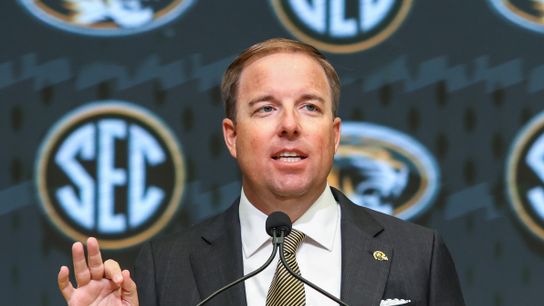We all have our preferred number when it comes to the College Football Playoff. Some prefer 12, others 14 or 16. Many among us still yearn for the days of four, or two, or even the old old days with no official national championship game. Ask the right person at the right time and you might find yourself sucked into a 2-hour seminar about why 10 is the proper number for a postseason tournament in major college football.
Missouri head coach Eli Drinkwitz is one of those people.
As the Tigers took their turn in the spotlight at SEC media days on Thursday, the Mizzou head coach came to Atlanta armed with talking points for his own Perfect Playoff Number -- and that number is 30.
"Now we're talking about an opportunity for 30 teams, 30 fan bases to be excited and engaged, giving revenue. Thirty teams with players who have access to compete for a championship. So for me, I think that makes a lot more sense," he said.
In an interview with On3's JD PicKell, Drinkwitz shed light on how and why he got to 30.
NEW: Eli Drinkwitz explains his 30-team College Football Playoff model with @jdpickell🏆
— On3 (@On3sports) July 17, 2025
“44% of the teams in the NFL make the playoffs. We're talking about 10% of college football teams are gonna make the playoffs, and we think that's gonna keep fan bases encouraged?” https://t.co/whjrpilVvC pic.twitter.com/dnhWmXjBP2
Upon further explanation, it appears Drinkwitz is stumping for the Big Ten's 4+ model, just packaged in different wrapping paper. Four play-in games (so, eight teams competing) in the Big Ten and SEC and three apiece in the ACC and Big 12 (six in each conference) adds up to 28 teams competing in play-in games in their respective conferences. This leaves, presumably, one bid for the highest-ranked Group of 5 champion and Notre Dame. This model is even more exclusive to the Power 4 than even the Big Ten model (where the ACC/Big 12 only get two bids), and totally contradicts other talking point, that only 10 percent of FBS teams make the CFP while 44 percent of the NFL teams make their playoffs.
Under the Drinkwitz Plan as laid out by the terms above, 42 percent of the Power 4 would have the opportunity to compete for a championship, while 1 of the 68 non-P4, non-Notre Dame teams would have the same opportunity. Under a 5+11 model (or the current 5+7 model), in theory at least, every team has the same opportunity and no conference is placed with an artificial limit.
"It doesn't make sense for the University of Missouri," Drinkwitz told ESPN of the current model. "It makes sense for blue bloods who are consistently ranked in the Top 25 and every year have the implicit bias of being ranked -- maybe not based off product, but based off of media marketing and branding. But if you're talking about in the SEC, you have to finish in the top eight to compete in the playoff? Or in the SEC you have to finish in the top three? That's a totally different challenge." This argument conveniently ignores that one of the great controversies of last season, the first under a 12-team format, is that the committee selected Indiana and SMU over Alabama.
Let's move on.
Drinkwitz is advocating for a model where simply finishing in eighth place in a 16-team SEC is enough to compete for a national title. As it so happens, Mizzou finished in seventh in the SEC last season.
Let's review who Missouri defeated in the regular season in 2024:
1-11 Murray State; 9-4 Buffalo; 7-6 Boston College (by six); 7-6 Vanderbilt (in double overtime); 2-10 UMass; 5-7 Auburn (by four); 6-7 Oklahoma (Mizzou trailed in the final two minutes); 2-10 Mississippi State; and 7-6 Arkansas (by seven). They lost to Texas A&M 41-10, 34-0 to Alabama, and at South Carolina by a respectable four points. You and I might say this was a team that feasted on poor competition, squeaked by against equal competition, and was exposed by good teams. Drink says this is a team worthy of competing for the game's ultimate prize.
Regardless, it's a team that few outside of Faurot Field were clamoring to see compete for a national championship.
Now let's zoom out of the SEC.
Last season, Oregon was the only team in FBS to survive the regular season unblemished. And they should have the same opportunity at a national title as 6-6 USC, who at 4-5 in league play edged out 7-5 Rutgers and 6-6 Washington for eighth place in the Big Ten? All so the fan bases in LA, Seattle and Piscataway can remain engaged through the end of the season? Did USC really "earn it on the field," as Drinkwitz says above? Did Missouri?
To put it politely, the juice is simply not worth the squeeze. By lowering the bar to the floor, it would pay out many more bonuses to coaches, though.
Finally, the real interesting point here is that Drinkwitz is switching sides in college football's most expensive and annoying ongoing debate. The 4+ model was the leading candidate for 2026 and beyond entering the SEC spring meetings, until SEC coaches joined the chorus of public opinion in effectively shouting that idea down. In May, all reporting indicated the SEC supported the 4+ model. In July, it supports 5+11. The Big Ten, however, still is not budging off the 4+ model. It's to the point now where it seems the most likely outcome is remaining with the current 12-team bracket, at least for the 2026 season.
And in the Big Ten's war of words with the SEC, the B1G on Thursday found an ally to the south.
